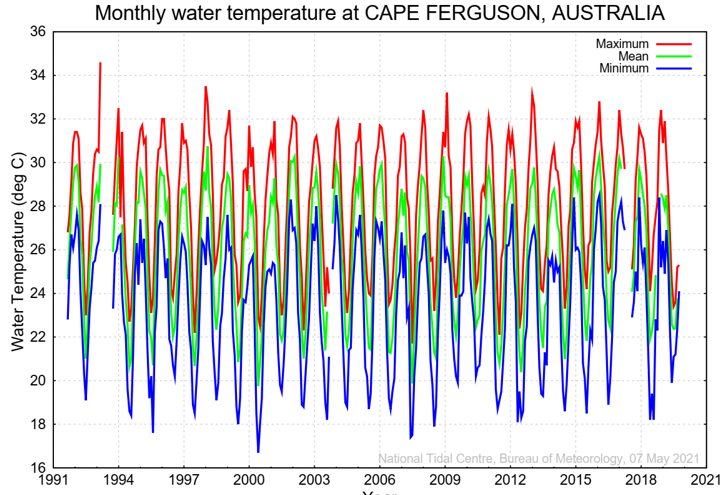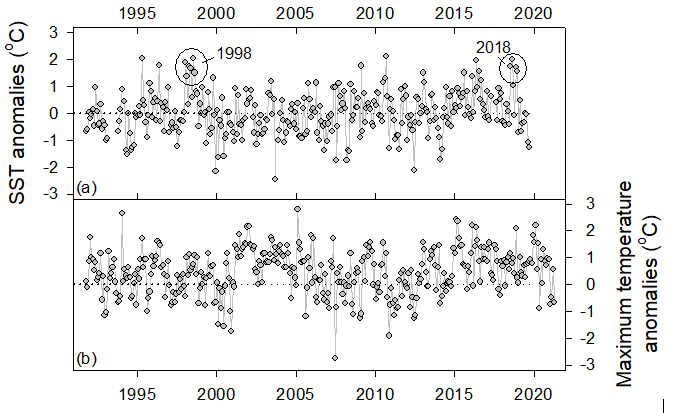
At what point does it become the moral and legal duty of scientists to speak out when an issue involving the integrity of science arises? This challenge has always existed but may be presenting itself in a new light over the issue of whether sea surface temperatures near the Great Barrier Reef are rapidly rising.
It was this challenging question that came strongly to mind when I was made aware of the two graphs below. The first is of the raw data from a sensor at the Australian Institute of Marine Science (AIMS) wharf at Cape Ferguson, not far from Townsville, Queensland. To the naked eye, and on an expanded scale, it definitely fails to show any rapid rise over the 29.5 years of observations.

Using basic statistical methods, if one digs deeper into the table of data supporting the graph the answer comes back the same – ‘No.’
After reviewing the Cape Ferguson data, natural resources research scientist Bill Johnston found a connection between sea surface temperature measured by the tide gauge and maximum temperature measured on-land, but no evidence of a trend uniquely due to warming of ocean waters in the vicinity of Cape Ferguson.
See also: Walter Starck, ‘Simple clear evidence the GBR is fine’
“If the numbers at Cape Ferguson are supposed to constitute part of the evidence for rapidly increasing sea surface temperatures in the vicinity of the GBR, they just don’t stack up,” says Dr Johnston. “If a rapid rise exists, we are going to have to look much further afield for the compelling evidence than just a wharf near the shore of the mainland.
“And if we go looking for the real evidence, we are going to have to find some obvious and sustained increases elsewhere in the Reef and its lagoon to compensate for the absence of an ocean-related trend at Cape Ferguson,” he says.
The second graph (below) shows Johnson’s work in ‘de-seasoning’ the annual swings in measured temperature due to the difference in the sun’s apparent position north and south of the equator. When the sun appears to be directly overhead, it is hotter, the days are longer and the water near the surface is warmer. When the angle of the Earth’s tilt makes the Sun appear to move north of the Equator, the reverse is the case – less solar heat, shorter days and cooler water. The annual swing in sea surface temperature is constant and not attributable in any way to changes in the climate.

Dr Johnston’s analysis of the de-seasoned data shows two clusters of warmer temperature (1998 and 2018) but no indication that sea surface temperatures are increasing rapidly or that they are likely to increase in the future.
The commonly held view that sea temperatures are rising in the GBR is widespread and the message is deeply entrenched, so much so that the topic is an almost guaranteed dinner-party-wrecker if seriously disputed by any of the guests.
But is it true?
The problem for our dinner party is that, like it or not, a clear-headed review of the observed sea surface temperatures in the GBR shows no rising trend in the data – at least not at Cape Ferguson. Most importantly, there is no such phenomenon in the data that would justify the use of the word ‘rapidly’.
So what is the duty of an ethical scientist at our notional dinner party – to wreck the party or just to stay quiet and avoid rocking the boat? What is the scientist’s obligation to draw people’s attention to the discrepancy between belief and reality? This is possibly one of the oldest challenges in science.
“At Cape Ferguson, there is a huge disparity between what people – and scientists – seem to believe and what the data says,” says Johnson. “True scientists should not sit back and allow this misconception to take hold in the public mind as the truth.”
While Cape Ferguson is a single instance, other sites around the GBR show the same inconvenient result. The AIMS site at Thursday Island, off the tip of Cape York (May 1998 to February 2019); Arlington Reef off Cairns (April 1996 to February 2020); Seaforth Island off Proserpine (July 2005 to February 2021) and Square Rocks, off Yepoon, show no discernible warming trend. It seems to be the truth that hyped talk of rapid rise in sea surface temperature is belief-based, not fact-based.
While Professor Peter Ridd’s ongoing ordeal for questioning the alarmist orthodoxy recommends caution and silence to the dubious but career-minded, there remains an obligation for those of influence and repute to blow their whistles. Science is about the pursuit of truth; to act other than in its pursuit represents an ethical and moral violation. It’s that simple.
The data for Cape Ferguson is available from the Australian Bureau of Meteorology via the website of its National Tide Centre’s Australian Baseline Sea Level Monitoring Project (ABSLMP) unit. ABSLM monitors seal level and sea surface temperatures at 16 sites around Australia and data can be viewed as PDF graphs and as tables. Please have a look for yourself. You might well be shocked by the disparity between the general belief and the reality revealed by the data. Please also bear in mind that the data you will find is not the work of some hair-brained contrarian sitting at a computer, blogging madly late at night and making it all up. It is official data! (I will deal with more of this data in greater detail in subsequent articles to be published on www.bomwatch.com.au
For the moment, however, let me focus on the Cape Ferguson site at the AIMS wharf, part of the baseline monitoring program referred to above. While AIMS is not directly responsible for the collection of the data (it is done automatically), the sensor is co-located at its property and, given the marine science role of AIMS, one might expect that the organisation would have more than a passing interest in the integrity of the Cape Ferguson data.
My emails to AIMS asking if the organisation finds fault with Dr Johnston’s analysis of the Cape Ferguson figures have not been directly addressed. I have received an email making some hand-waving general points about sea surface-temperature rises but no specific comment about the Cape Ferguson dataset. I have repeated my request but, to date, heard nothing back. Silence can sometimes be more accurate than a million words.
It’s all a bit disheartening. Very few individuals appear ready to acknowledge that they under a moral and or legal obligation to speak out about the chasm between belief and empirical data when it comes to sea surface temperatures near the Reef.
And there is a further question that opens out from this. At what point do we expand the personal moral or legal duty of an individual to examine the wider scope of the legal duty of a corporate entity, such as a university or publicly funded research organisation? Not only is it intolerable that individual scientists dodge their duty to uphold truth, it is perhaps even more intolerable when a corporate entity does the same.
Research organisations we are expected to trust cannot be granted the luxury of legal immunity when they make claims that cannot be substantiated — or when they choose to remain silent when challenged by obvious discrepancies.
I opened this essay by posing the question about when any and every scientists’ personal moral or legal duty to speak-out clicks in. The disheartening thing is that this point of law is not yet clearly determined, and the law seems more porous on this subject than it does in, say, the commercial world when a company – a corporate legal entity – issues a false or misleading prospectus.
Let’s hope the persistence of scientists like Dr Johnston gives heart to others to speak out when they see instances like Cape Ferguson.
Our systems of quality control in science need teeth, not more funding for flawed science based on foundations of wrong, or shaky, data.
David Mason-Jones is a freelance journalist of many years’ experience and a contributor to Quadrant Online. He can be contacted at publisher@bomwatch.com.au
Dr Bill Johnston is a former NSW Department of Natural Resources senior research scientist and former weather observer. His email contact is scientist@bomwatch.com.au
Links and further reading
To view the graphs and tables of the ABSLMP data in full visit http://www.bom.gov.au/oceanography/projects/abslmp/data/monthly.shtml
For more information about climate of the GBR visit http://www.bomwatch.com.au
 Sign In
Sign In 0 Items (
0 Items ( Search
Search









Bodies spreading, or failing to correct, false measurement data and inferences from it, are in need of punishment.
If I, a scientist, knowingly salted an emerging gold mine, I would expect to be jailed. Mind you, I know I have advanced skills to make false mining data look credible, but that is not the point, which is that it does improve the probability of detecting fraud by others.
Here, Dr Johnston is acting properly in the name of good science. Scientists like him are to be taken as normally expected, with or without praise. The reverse, that scientists with lesser probity should be punished, is not adequately exercised, but there will be a rebellion against pseudo science at some time. There are even small signs that it has commenced. Geoff S
The University of Queensland has collaborated in a Reef Watch satellite sensing scientific endeavour to look at reef bleaching and the impact of pollutants.
https://www.uq.edu.au/news/article/2021/05/real-time-satellite-system-monitor-global-reef-bleaching
However while this may be a virtuous and expensive exercise one wonders at the accuracy, validation and replication to be garnered from this project.
Of late the debate about coral bleaching on the GBR has centred on the ability of anyone in a light aircraft at 150 metres being able to actually measure such bleaching.
https://jennifermarohasy.com/2021/02/fly-past-coral-surveys-and/
‘My issues relate specifically to the aerial surveys of coral bleaching ………….from which it has been concluded that the Great Barrier Reef is half dead.’
This raises the question, can a satellite do better?
If so, who and what algorithm interprets the data and how is it validated to be of use in the real world?
Is it to be validated by the self same light aircraft, low altitude survey, shown by divers to be way off the mark, to the detriment of tourism and our sovereign good name as providers and real carers of our GBR?
https://jennifermarohasy.com/coralreefs/
Its time to call a moratorium from dodgy Angel Fish Studies and their ilk.
The Reef deserves this.
Ethics? Moral and legal obligations?
Any proper emprical assessment would conclude this:
“There is more evidence against than for the existence of the practice of proper scientific technique in most fields -outside research in the applied areas of medicine, dentistry and animal health fields, and non-environmental engineering, and in the pure areas of chem, physics and some biology, mostly.
Esp in the “climate” and “sociology” related fields, it’s all subject to corruption -either by careerism and/or by (fake) virtue-obsessed idealism by which “scientists” want to “save the Planet and all its peoples”, esp by way of diversity, inclusion, affirmative action, and anti-factuality as required.
The very bases of ethics and morality went down the drain some decades ago.
And the legal system, on balance, now supports marxist/greenist/anti-empirical ideology in all key areas, esp in the treatment of violent criminality, insurrection by anti-Westernist agents of various stripes, and the insane.
Thanks David, for your persistent and detailed investigation of this issue. For readers who are interested in the fate of GBR, I urge them to get hold of David’s book ‘Will the Great Barrier Reef Survive – Doubting the Doomed Reef Scenario’, available at journalist.com.au. It draws heavily on the work of Dr Peter Ridd and is a comprehensive coverage of this emotive topic.
In less than 4 weeks, Peter Ridd’s case will be heard in the High Court, although a decision will likely be withheld following that for a period, I expect. Even then, it will be decided on the narrow grounds of the meaning of various clauses in the Uni’s Enterprise Agreement. The decision of the full Federal Court appeal on this (not the initial single judge decision) is my evidence for this guess.
Certainly, David Mason-Jones’ essay here is valuable in precise cataloguing of the “courageous” refusal by AIMS and the BoM to deal with empirical data that squarely contradicts their various press releases.
All of that is to say in my view, scientific method is being constantly corrupted.
Come on, let’s get real. It’s not about any scientific truth, it’s about protecting their jobs which are controlled by the neo-Marxists in administration. Lysenko and Stalin would be so proud.
DM: “At what point do we expand the personal moral or legal duty of an individual to examine the wider scope of the legal duty of a corporate entity, such as a university or publicly funded research organisation?”
There is an Australian Code for the Responsible Conduct of Research (ACRCR 2018).
It is described as “a principles-based document that articulates the broad principles and responsibilities that underpin the conduct of Australian research”.
It includes “honesty, rigour and accountability in the development, undertaking and reporting of research”.
https://www.nhmrc.gov.au/about-us/publications/australian-code-responsible-conduct-research-2018
Yet there’s so much dodgy research out there. Especially rife are naughty “predictions” about “climate change” and its alleged effects today, or in 2030, 2050, etc.
The stakes have become so high that few today have the courage to expose the fraud, least of all the political classes, corporate entities and investment banks/bankers that now have their snouts well and truly in the green-swill trough.